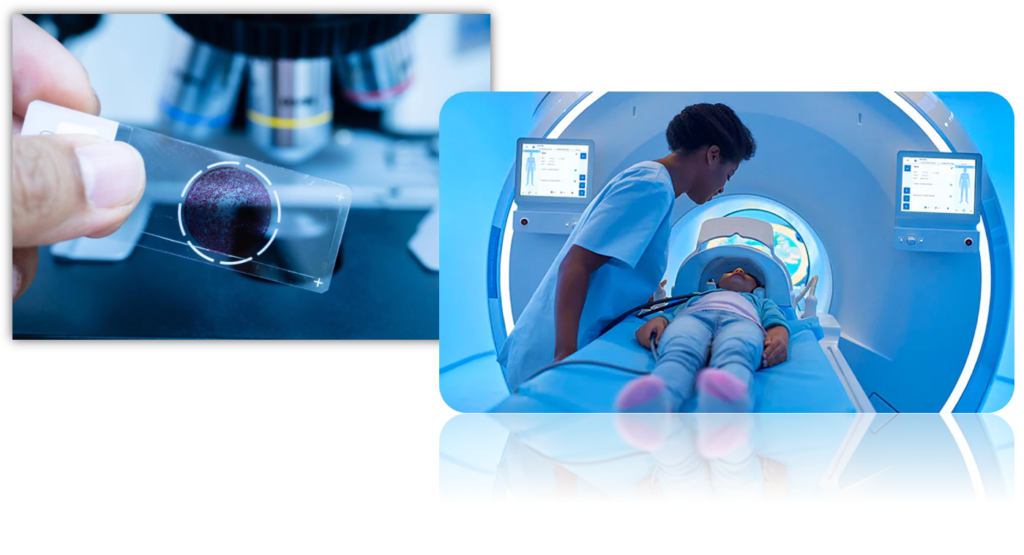In this blog, we will see the different segments and sub-segments of Pathology and Radiology.
In the last blog, we saw that there are different ways to segment the Diagnostics market. One way is to see Pathology and Radiology as sub-industries of the Diagnostics industry. Of the two, Pathology has a 58% market share. This type of market segmentation is of interest and importance to investors for analysis of the companies in the listed space. (Featured image credits: https://www.news-medical.net/health/What-is-Pathology.aspx and https://www.philips.com/a-w/about/news/archive/blogs/innovation-matters/2020/20201124-seven-innovations-in-radiology-workflow-that-are-improving-efficiency-and-quality-of-care.html)
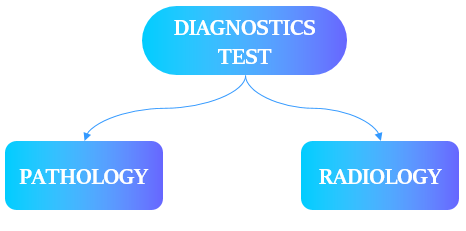
Note: There is no one standard way of grouping/classifying the tests. There are different ways shown on the internet. I have arrived at this based on the classification used in the DRHP of the listed companies.
Brief Background of this Blog Series
Diagnostics Industry was of interest to me since 2017. However, I could spend dedicated time only during 2021 to study this industry. The contents that you see in the coming blogs were mined from Annual Reports, Concalls, RHP, Management interviews and a few Twitter spaces by Mr Aditya Khemka and Dr Velumani.
Hi, This is Venkatesh. I write on Personal Finance, Stock Investing, Productivity and Time Management. You will be interested to read more about me and the purpose of my website.
If you are interested in these topics do subscribe to my blogs. You would maximum receive 4 to 5 emails a month.
You might also be interested to read these related articles:
Business Segments in Pathology
Pathology tests has two broad segments based on methods used and types of diseases targeted for investigation as:
Clinical Pathology
These tests diagnose diseases through the study of chemical and biochemical mechanisms of the human body, such as detecting changes in electrolytes and enzymes in the blood and body fluids samples (Such as blood or urine) to analyze for various diseases. Common clinical pathology tests include, among others, blood sugar level tests, lipid profiles, pregnancy tests, cholesterol tests and blood cell count tests. You may refer to https://en.wikipedia.org/wiki/Clinical_pathology for more details.
Clinical pathology has the following major sub-segments:
- Biochemistry
- Immunology
- Hematology
- Microbiology
Each of these tests target different diseases.
Biochemistry
Disease targeted: Mainly chronic disease
Details of the test: Test the composition of body fluid samples and compare with health samples to identify disease or analyse the general health condition of patients. This covers tests for blood sugar, cholesterol and triglycerides, urea and creatinine, among others, are increasingly being prescribed by doctors to identify cardiovascular diseases, diabetes and cancer.
Most of the tests in the Preventive test packages are from Biochemistry. These tests are machine driven. Due to which scaling of these tests is easy and companies benefits from economies of scale. Thyrocare, one of the Diagnostic chains is a large player in this Sub segment (There could be changes in this strategy under the new management from 2021.)
Immunology
Disease targeted: Disease caused by abnormal immune response
Details of the test: Measure of the immune system through analysis of blood serum components such as total serum antibodies (IgG, IgA, and IgM), circulating lymphocyte subsets, auto antibodies, etc.
Hematology
Disease targeted: Disease affecting the blood of patients
Details of the test: Investigations include the use of special instruments such as a coulter counter to measure the number of various blood cells, microscopic analysis of blood to ascertain the shape and size of certain blood cells to ascertain diseases, such as anaemia and leukaemia, and clotting and bleeding studies to ascertain diseases, such as haemophilia.
These tests have a human involvement. Scaling is a challenge and it is also difficult to reduce the cost of these tests.
Microbiology
Disease targeted: Disease caused by bacterial, virus or fungi
Details of the test: Culturing organisms from specimens, such as urines, faeces and swabs to identify pathogens.
Of the above sub-segments, Biochemistry tests is estimated to have a larger share among pathology services.
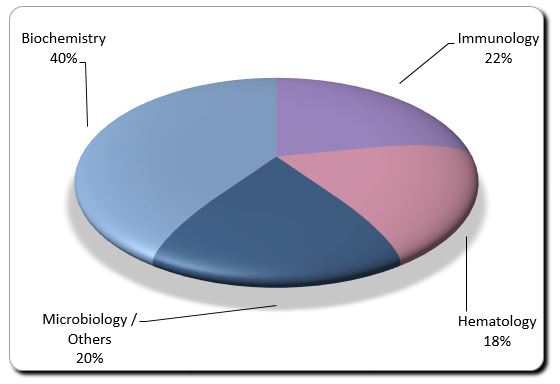
Source: Thyrocare DRHP, Page 106
Anatomical Pathology
Anatomical tests are aimed at diagnosing diseases, such as cancer, through macroscopic, microscopic, biochemical, immunologic and molecular examination of organs and tissues study of organs and tissue samples. The tissue samples may consist of tissue obtained from any part of the human body using biopsy techniques, specimens of separated cells in fluids, or tissue smears.
The sub-segments of Anatomical Pathology are:
Surgical pathology
Surgical pathology is the study of tissues removed from living patients during surgery to help diagnose a disease and determine a treatment plan. Surgical pathology includes both the physical exam of the tissue with the naked eye, as well as examining processed tissue under a microscope. Examples:
- Test to distinguish between benign (noncancerous) and malignant (cancerous) white blood cells
- Detect early genetic changes that may result in cancer
- Identify infectious agents in body tissues.
Refer https://en.wikipedia.org/wiki/Surgical_pathology for more details.
Histopathology
It is the examination of a biopsy or surgical specimen by a pathologist after the specimen has been processed and histological sections have been placed onto glass slides. Refer https://en.wikipedia.org/wiki/Histopathology for more details.
Cytology
In contrast to histopathology, cytology studies and diagnoses diseases on the cellular level by examining free cells or tissue micro-fragments
Molecular Pathology
This is the study and diagnosis of disease through the examination of molecules within organs, tissues or bodily fluids. You may refer to https://en.wikipedia.org/wiki/Molecular_pathology for more details.
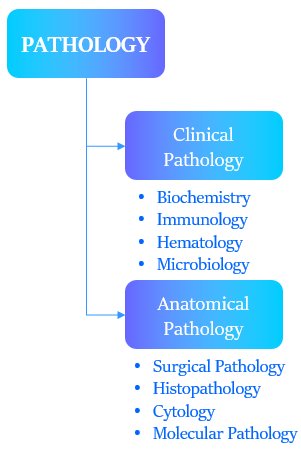
Business Segments in Radiology
This segment is divided into Low-end radiology and High-end radiology. We discussed in our earlier blog the challenges in Radiology segments. The investment is high, scaling is difficult and many more. The diagnostic equipment is required close to the patient. Hence Radiology services cannot be centralized and, as a result, are difficult to scale up.
Thus it is not easy to set up a Radiology lab, like a Pathology lab. In the organized space, Krsnaa Diagnostics is a focused player in the Radiology segment.
The image shows the different tests/sub-segments.

Testing at various stages of disease
There is yet another classification of tests based on the stage at which these tests are done. This is not a market segmentation, but rather a kind of classification/grouping of various tests.
- Predictive tests: Provide information about whether or not someone will develop or are likely to develop a specific condition, usually at a later stage in life. The test is usually performed on a blood sample.
- Early detection tests: Detect any ailment at an early stage so as to prevent the advancement of disease. Early detection is important because, it may be easier to treat. By the time symptoms appear, the disease or ailment may have begun to spread to advanced stages and be harder to treat.
- Diagnostic tests: Confirm or determine the presence of disease in an individual suspected of having the disease, usually following the report of symptoms or based on the results of other medical tests.
- Confirmatory tests: Confirm or rule out a medical condition in an individual with concerning symptoms or an out-of-range screening result.
- Prognostic tests: Predict the likely or expected development of a disease, given the current state of disease and treatment.
- Theranostic tests: Integrate some form of diagnostic testing to determine the presence of a molecular target for which a specific drug is intended.
- Monitoring tests: Monitor the progression of the disease and the effectiveness of the treatment administered to the patient.
Source: Metropolis DRHP Page 123
Putting it all together…
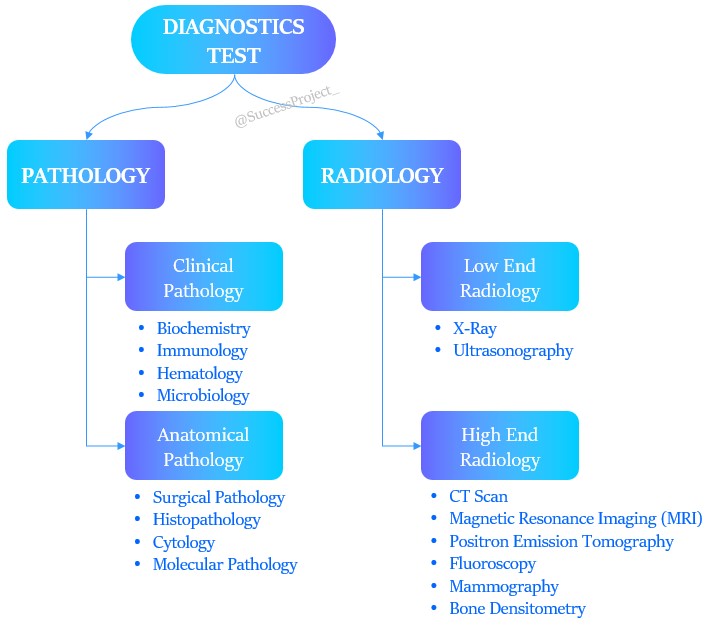
To close…
In this blog, we discussed in detail the segments and sub-segment within Pathology and Radiology. In the next blog, we will move to an important topic, “The Diagnostics Industry Ecosystem”
Hope you found this blog useful. Do share my blogs with your friends, peers and fellow investors.

